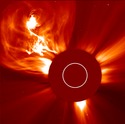
Mass Eruption: This image from SOHO on Jan. 4, 2002, shows a coronal mass ejection, or CME, as it shoots out into space -- the disk in the middle is a result of its coronagraph instrument, which blocks the light from the sun so that the fainter solar atmosphere can be seen. |
|
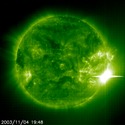
Extreme Solar Flare: The bright flash on the right side of the sun shows the most powerful flare on record -- categorized as an X 28 -- captured in this image by SOHO on Nov. 4, 2003. |
|
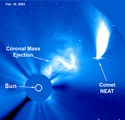
Dynamic Solar Atmosphere: A coronal mass ejection, or CME, exploded from the sun on Feb. 18, 2003, at the same time that Comet NEAT, discovered by a ground-based observatory in 2002, entered SOHO's field of view.
|
| |
| |
| |
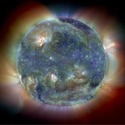
Colorful Sun:
SOHO watches the sun in several wavelengths of extreme ultraviolet light simultaneously, each of which highlights a different aspect of the sun's surface and atmosphere -- here
in an image from May 1998 the wavelengths of 171 angstroms, 195 angstroms, and 284 angstroms have been colorized and combined.
|
|
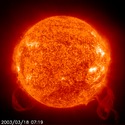
Dancing Loops:
On March 18, 2003, SOHO observed two giant ribbons of solar material floating in the atmosphere, known as prominences -- a dozen Earths could fit inside each one.
|
|
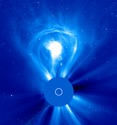
Lightbulb CME:
This image of a lightbulb-shaped coronal mass ejection, or CME, was captured on Feb. 27, 2000, by SOHO's wider-angle coronagraph-- illustrating a text book image of a CME with a spreading outer boundary around a dense, bright center.
|
| |
| |
| |
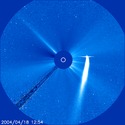
SOHO As Comet Observer:
Comet Bradfield passed through SOHO's field of view on April 18, 2004, less than a month after it was originally discovered by an amateur astronomer.
|
|
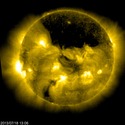
Black Spot on the Sun:
This extreme ultraviolet image of the sun, taken by SOHO on July 18, 2013, revealed a large coronal hole, an area on the sun where the magnetic field
is open to interplanetary space, sending coronal material flying out in a high-speed solar wind stream.
|
|

Comet ISON:
This composite image from SOHO on Nov. 28, 2013, shows Comet ISON as it rounded the sun -- coming in from the lower right and exiting through the top right, breaking up during the process.
|
| |
| |
| |
|